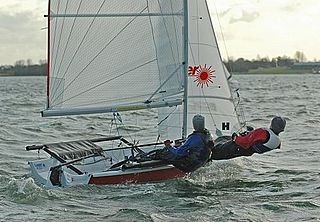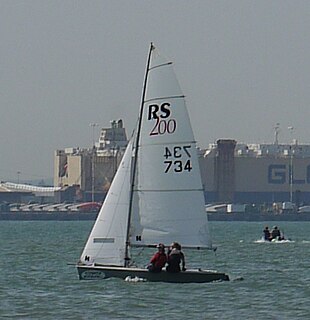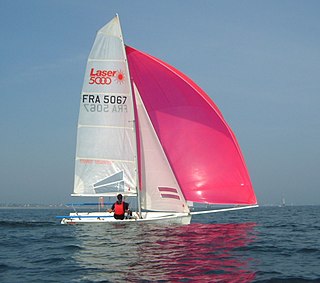Related Research Articles

Dinghy sailing is the activity of sailing small boats by using five essential controls:

Dinghy racing is a competitive sport using dinghies, which are small boats which may be rowboats, have an outboard motor, or be sailing dinghies. Dinghy racing has affected aspects of the modern sailing dinghy, including hull design, sail materials and sailplan, and techniques such as planing and trapezing.

The Enterprise is a Bermuda rigged sailing dinghy with a double-chined hull and distinctive blue sails. Normally crewed by two, and sometimes carrying a third crew member, it may also be sailed single-handed.

The 49er and 49er FX is a two-handed skiff-type high-performance sailing dinghy. The two crew work on different roles with the helm making many tactical decisions, as well as steering, and the crew doing most of the sail control. Both of the crew are equipped with their own trapeze and sailing is done while cantilevered over the water to the fullest extent to balance against the sails.

The International 420 Dinghy is a sailing dinghy popular for racing and teaching. The hull is fiberglass with internal buoyancy tanks. The 420 has a bermuda rig and an optional spinnaker and trapeze. It has a large sail-area-to-weight ratio, and is designed to plane easily. It can be rigged to be sailed single-handed or double-handed. The 420 is an International class recognized by World Sailing. The name refers to the boat's length of 420 centimetres.
The Laser Vortex is a high performance sailing dinghy designed by Jo Richards and awarded the "Sailboat of the Year" title on its introduction in 2000. It is a tunnel hulled single hander that has a trapeze and an optional asymmetrical spinnaker. It is manufactured by White Formula UK Ltd under licence from a consortium headed up by Jonathan Carter. Jo Richard remains the owner of the design. Laser Performance are no longer involved with the Vortex. In 2013 the decision was made to drop 'Laser' from the name, the boat is now known only as the Vortex.

The Laser 4000 is a racing dinghy designed by Phil Morrison crewed by two persons. Its one-design weight-equalised system enables physically differing sailors to compete on a level playing field. It is most popular in Europe, particularly the UK, France and Italy.

The RS300 is a modern racing sailing dinghy made by RS Sailing. The RS300 is a one-design, single-handed, hiking dinghy with a PY of 972. Designed by Clive Everest and first produced in 1998, it is inspired by the International Moth, of which Everest was a successful designer.

The RS800 is a light-weight sailing dinghy designed by Phil Morrison and manufactured by RS Sailing. The boat is sailed by two people both on trapeze and has a main, jib and spinnaker. The RS800 has a Portsmouth Yardstick number of 799 and a D-PN of 77.0. There is a large racing circuit in the UK, and some European events each year.

The RS200 is a 4m, double handed, hiking, racing dinghy. Designed in 1995 by Phil Morrison and manufactured by RS Sailing. It has a lightweight polyester GRP with Coremat hull construction.

The Laser 3000 is a racing sailing dinghy crewed by two persons with a trapeze for the crew. Launched in 1996, the 3000 was developed from the Laser 2, using the original Frank Bethwaite-designed planing hull combined with a brand new self-draining deck by Derek Clark. Clark also re-designed the rig, using spars and sails from premium proprietary sources and replacing the symmetric spinnaker of the Laser 2 by a larger asymmetrical spinnaker. The gennaker is chute-launched and retrieved using a single halyard line, and is set on a retractable bowsprit. Helm balance and handling were improved using a shorter-footed mainsail with two full-width battens giving a larger roach. A mast with conventional spreaders replaced the now-unusual diamond arrangement of the Laser 2.

The 3000 is a racing sailing dinghy crewed by two persons with a trapeze for the crew. Launched in 1996 as the Laser 3000, the 3000 was developed from the Laser 2, using the original Frank Bethwaite-designed planing hull combined with a new designed self-draining deck by Derek Clark. Clark also re-designed the rig, using spars and sails from premium proprietary sources and replacing the symmetric spinnaker of the Laser 2 by a larger asymmetric spinnaker (gennaker). The gennaker is chute-launched and retrieved using a single halyard line, and is set on a retractable bowsprit. Helm balance and handling were improved using a shorter-footed mainsail with two full-width battens giving a larger roach. A mast with conventional spreaders replaced the now-unusual diamond arrangement of the Laser 2.

The RS400 is a light-weight sailing dinghy designed by Phil Morrison and manufactured by RS Sailing. The dinghy is sailed by two people and has a main, a jib and an asymmetric spinnaker. It has a PY of 948 and a D-PN of 82.3.
The RS500 is a double handed trapeze skiff designed by Phil Morrison, manufactured and designed by RS Sailing. The class has a PY number of 972. There are two sail size options and makes the RS500 suitable for youngsters and adults. With ISAF Recognised Status, the RS500 has a racing circuit with events in UK, Europe and World Championships.
The RS700 is a single-handed racing dinghy built by RS Sailing and designed in 2000 by Nick Peters and Alex Southon as part of the RS series and built in 2001. It is raced in many sailing clubs around Britain, with a PY number of 850 and a D-PN of 73.3.

The Buzz is a sailing dinghy designed in 1994 by Ian Howlett and John Caig and manufactured by Reg White Limited of Brightlingsea as part of the "White Formula" range of boats originally marketed by Topper International Ltd but since 2013 by Vantage Sailing. The Buzz is a double handed racing boat, with a single trapeze for the crewman. The boat has a fully battened mainsail, furling jib and an asymmetrical spinnaker. There have been around 500 boats built. The Buzz is designed to be an easy to sail boat, but it can also be raced competitively.

RS Sailing is an international designer, builder and supplier of sailboats and dinghies and associated goods and services supported by a worldwide dealer network and class associations.

The Laser 5000 is a double-handed, dual trapeze skiff with an asymmetrical spinnaker. It derives its name from its length of 5 metres. Losing out to the Bethwaite-designed 49er for selection as an Olympic class for the 2000 Games, it was one of 11 designs that took part in the ISAF High Performance Olympic Dinghy Evaluation Event in 1996.
ISO is an International Sailing Federation (ISAF) class of two-person sailing dinghy with a single trapeze and an asymmetric spinnaker. The ISO was designed in 1993 by Ian Howlett and John Caig and manufactured by Reg White Limited of Brightlingsea as part of the "White Formula" range of boats originally marketed by Topper International Ltd and since 2013 by Vantage Sailing Ltd. The boat has a fully battened mainsail, jib and an asymmetric spinnaker.

The RS100, first launched in 2009 by RS Sailing, is a singlehanded skiff. Possessing an asymmetric spinnaker the boat has two PY numbers of 981 for the 10.2 rig and 1004 for the 8.4 rig. The RS100 has a racing event circuit in the United Kingdom and in Europe, with the Eurotour beginning in 2011.
References
- ↑ Yachts & Yachting Archived 2011-09-09 at the Wayback Machine
- ↑ UK RS Association
- ↑ "Portsmouth Number List 2012". Royal Yachting Association. Retrieved 31 July 2012.
- ↑ "Centerboard Classes". US Sailing. Archived from the original on 16 August 2012. Retrieved 31 July 2012.
- ↑ RS Sailing South Africa Archived 2012-03-04 at the Wayback Machine